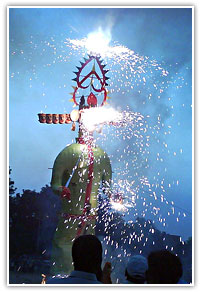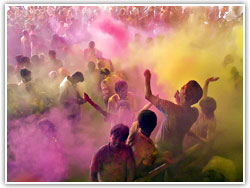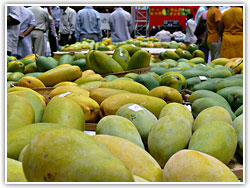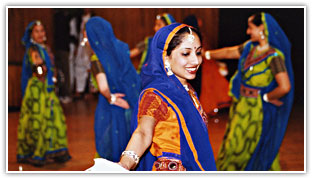|
|
Festivals of North India
.............................................................................................................................................................................. |
|
|
|
India is a land of diversities.
The people of every faith and religion live in
unity and as well as celebrate various festivals
in the country. In no other country of the world
are people so frequently motivated by a religious
urge to travel as in India. Fortunately for the
Hindus, most of their places of pilgrimage are at
scenic places in the Himalayas or near the sea or
rivers. There is perhaps not a single day in the
Indian calendar when a festival or fair is not
celebrated in such a vast country with varied
religions. There are some national festivals which
are celebrated all over North India like Makar
Sankranti, Republic Day, Holi,
Raksha Bandhan, Independence Day, Janmashtami,
Dussehra, Diwali and Christmas. Then, there are
festivals to celebrate change of seasons,
festivals connected with the harvesting or sowing
of crops, etc. Every happy occasion calls for a
celebration accompanied with dance and music. But
the various |
 |
|
|
festivals are not celebrated by
everyone in the country. Besides these, there are
festivals associated with pilgrimages. Hindu, Buddhist,
Jain and Sikh pilgrim centers are located almost in
every corner of India attracting millions of devotees
travelling from one part of the country to another. For
instance, the Kumbha Mela (celebrated every 12 years) at
Haridwar or Prayag (Allahabad) attracts a few million
people each time. While the dates of the national
festivals are known, other festivals follow the lunar
calendar and the dates change almost every year.
However, the dates do not differ too much.
If you plan to include an Indian
festival in your itinerary, please check its date with
North India Tours Team. We would be delighted to make
your trip to India a more enjoyable and fulfilling
experience. The North India Tours Team keeps itself
updated with the dates of the several festivals which
are known to us in advance. Given below is a month-wise
list of the various festivals celebrated in the Land of
diversities.
North Indian Festivals
January
Republic Day
The Republic Day is celebrated on the 26 January all
over the country. The India became republic on 26th
January 1950 and from this day this festival is
celebrated as a national festival. The day is celebrated
traditionally with hoisting of the national flag, a
parade and official festivities. The main attraction
takes place at New Delhi, where a spectacular parade
consisting of the Armed Forces, school children and
youth, and folk dancers move down from the magnificent
Rashtrapati Bhavan, past the India Gate and onto the
historic Red Fort. On 29 January a breathtaking Beating
Retreat ceremony takes place, set against the
Rashtrapati Bhavan when the Armed Forces bands play
martial music and march forming intricate patterns. This
is followed by a colourful display of flares and
illumination of the Rashtrapati Bhavan and other
buildings around.
Lohri
In the north particularly in Punjab, the day before
Makar Sankranti is celebrated as Lohri. Lohri is the
time after which the biting cold of winter begins to
taper off. On this day the children go from door to door
and collect funds for the community bonfires which are
lit in the evening. Lohri is more of a community
festival, where the birth of a son or the first year of
marriage is celebrated with great fun and frolic. People
gather around the bonfires and offer sweets, crisp rice
and popcorn to the flames. Songs are sung to the beat of
vigorous claps and greetings are exchanged.
Id–ul–Fitter
This festival celebrates the end of Ramzan, the Muslim
month of fasting. It is an occasion of feasting and
rejoicing. The faithful gather in mosques to pray and
meet their friends and relatives and exchange greetings
with each other. Prayers, family get–togethers and
feasts are the major highlights of the celebrations. Idi
or presents of money are given to the youngsters by the
family elders, conveying their blessings.
February
Mahashivaratri
On the 14 night of the dark half of the month of Magh,
the festival of Mahashivaratri is celebrated, the great
night of Lord Shiva. The devotees stay awake throughout
the night and offer their prayers to Lord Shiva. They
offer special food made from the fruits of the season,
root vegetables and coconuts to Lord Shiva. The devotees
fast for the whole day and in the night ate the Prasad
offered to Shiva. Special celebrations are held in some
of the major Shiv temples at Varanasi.
Vasant Panchami
Vasant Panchami is celebrated to welcome the spring
season on the fifth day of the waxing moon of Magh or
February. On this day, the goddess Saraswati, Durga and
Lakshmi are worshipped. People wear colourful dress,
especially in bright shades of yellow and participate in
dance, music and merriment. In West Bengal and northern
parts of India, the goddess Saraswati-the goddess of
learning is worshipped by placing ‘instruments of
learning’ at her shrine. The festival is celebrated with
great fervor in the university town of Shantiniketan in
West Bengal.
International Yoga Week
During the International Yoga Week, various Yoga
sessions are held along the banks of the Ganga at
Rishikesh in February. This Yoga week is organized by
the U.P. Tourism. Different lectures and Yoga Asanas are
demonstrated by the prominent Yoga experts throughout
the week. One other attraction of this week is the
fascinating water sports on the Ganga.
Taj Mahotsav
The Taj Mahotsav is celebrated in Agra for almost ten
days. This festival brings together the finest Indian
crafts and cultural nuances at one place. It is a
festive introduction to India and Uttar Pradesh. Folk
music, Shayari (Poetry), classical dance performances,
elephant and camel rides, games and food festival are
the part of the festival.
Surajkund Crafts Mela
Surajkund Crafts Mela is a delightful handloom and
handicrafts fair which is held annually at Surajkund in
Delhi. This fair is celebrated in order to promote the
traditional Indian handicrafts. Skilled artisans and
craftsmen display their skills and crafts in a rural
setting. Cultural programmes and rural cuisine are also
a part of this colourful fair.
March |
| |
|
Holi
Holi is popularly known as the ‘colour throwing
festival’. This festival is celebrated by the
people all over the country. Holi is a spring
festival which is celebrated normally over two
days in the month of March. On the evening of the
first day bonfires are lit, to symbolise the
destruction of evil. On the next day the people
throw colored powder and water on each other and
exchange sweets. In various other parts of India
Kama, the god of pleasure, the presiding deity of
Holi is also worshipped. |
 |
|
|
Lord Krishna is also
worshipped by various people to commemorate the
destruction of the female demon Putana by the Lord
Krishna.
Rama Navami
Rama Navami is celebrated as the birthday of Lord Rama.
This festival is celebrated all over the country,
particularly in Uttar Pradesh. During the eight days
preceding the birthday it is considered auspicious to
read or listen to the epic Ramayana. So the celebrations
involve reading and staging of the Ramayana in various
folk forms.
Id–ul-Zuha or Bakra-Id
Id-Ul-Zuha is a Muslim festival which is celebrated all
over India. This festival commemorates the Ibrahim’s
sacrifice. Prayers are offered in the mosques and
special delicacies are prepared and served among the
families and friends on this day.
Khajuraho Dance Festival
Khajuraho Dance Festival is a weeklong dance festival
which is held every year during the month of March in
Khajuraho, Madhya Pradesh. This dance festival is
organized by the Madhya Pradesh Tourism Department and
is promoted as one of the major cultural event in
Khajuraho. This dace festival is organized against the
background of the famous Khajuraho temples built by the
Chandela kings. During this dance festival various
classical dances are performed which feature the best
artistes of the country. This festival has earned a
great deal of reputation among the local and foreign
tourists.
April
|
|
Baisakhi
Baisakhi is celebrated as an important day by the Sikhs
in Punjab. It was on this day that Guru Govind Singh
founded the Khalsa. At all Gurudwaras the ‘Granth
Sahib’, the holy book of the Sikhs is read from
beginning to end and taken out in a procession by the
Panch Pyaras (five senior Sikhs) who are symbolic of the
original leaders. After this there is a lot of feasting.
In the night the Baisakhi di Raat or Baisakhi da Mela is
held in which various folk dances, especially the
Bhangra dance is performed and men and women dance to
the rhythmic beat of drums. In Kerala the festival is
known as Vishu. A display of grain, fruits, flowers,
gold, new cloth and money, is viewed early in the
morning to ensure a prosperous year ahead. This festival
is also known as Rangali Bihu in Assam, and is
celebrated with lively dance, music and feasting.
Mahavir Jayanti
Mahavir Jayanti is celebrated as the birth anniversary
of Lord Mahavira, the founder of Jainism. It is one of
the most famous festivals of the Jain community. On this
day, the Jains visit the sacred temples and offer
prayers.
Muharram
Muharram is celebrated as a day of mourning on the
occasion of the martyrdom of Imam Hussain, the grandson
of the holy Prophet Mohammad. This festival is mainly
celebrated by the Shi’ite Muslims, who take out
procession of colourfully decorated ‘Tazias’, which are
paper and bamboo replicas of the martyr’s tomb at
Karbala in Iraq. Tazias are carried in procession
through the streets while men beat their chests and
distress. The processions are especially impressive at
Lucknow and Hyderabad. In some parts of the south India,
the tiger dancers, men painted with stripes and wearing
tiger masks, lead the procession.
Buddha Purnima
Buddha Purnima is celebrated on the full moon day in
North India. On this day the Lord Buddha born and also
achieved Nirvana or the extinction of self and freedom
from the cycle of rebirth on the same day.
Good Friday and Easter
Good Friday is celebrated all over India by the
Christians. On this day the Lord Jesus Christ was
crucified. Easter Sunday is celebrated on the occasion
of the rebirth of Christ, as the triumph of good over
evil. It is a festival of rejuvenation of life and
living. A popular custom of this feast is the making of
Easter eggs with presents for children inside them.
Chocolate eggs, small chicks of cotton wool and almond
sweets are bought for children. The festival is
celebrated with lot of fun and frolic and the Christians
offer special prayer services.
June
|
|
Mango Festival
The famous Mango Festival is held in the month of
June in Saharanpur, in Uttar Pradesh, in every
mango season. In this festival innumerable
varieties of the mangoes are displayed.
July
Guru Purnima
On Guru
Purnima all the teachers are specially worshipped.
Ved Vyasa, the author |
 |
|
|
of the
great epic, Mahabharata, is also worshipped on this day.
On this day the students worship their elders, teachers
and guides in order to show respect to them with gifts
of coconuts, clothes and sweets. Discourses are held in
community gatherings to hear the reading of the holy
book, Bhagwad Gita. |
|
August
Independence Day
Independence Day is the national festival of India and
is observed throughout the country on 15th August. On
15th August, 1947 India got independence and later from
this day onwards it is celebrated as Independence Day.
Janmashtami
Janmashtami is celebrated on the occasion of the birth
anniversary of Lord Krishna. This festival is celebrated
at midnight in all the temples of Krishna all over the
country. It is celebrated with great enthusiasm at
Mathura and Brindavan where Lord Krishna spent his
childhood. Colorful Raslilas, song and dance dramas
depicting the life of Lord Krishna are performed all day
and night. On this day the night long prayers are
offered, religious hymns are sung in temples and various
scenes are enacted from Lord Krishna’s early life. In
Maharashtra, earthen pots of curd and butter are hung
high up over the streets and young men form pyramids and
try to break these pots. This is an act in imitation of
the Lord who when young, often stole butter and curds
kept in earthen pots out of his reach.
Rakshabandhan
Raksha Bandhan is the famous Hindu festival which is
celebrated mainly in north India. This is a festival
when brothers and sisters reaffirm their bonds of
affections. The sisters tie colourful threads or rakhis
on their brother’s wrist wishing for their long life.
The brothers in turn promise to protect the honour and
help them in adversaries and also gave them gifts. The
sea God Varuna, a Vedic deity, is also worshipped on
this day and is as such known as Narial Purnima or
‘Coconut Full Moon’.
October
Gandhi Jayanti
Gandhi Jayanti is the national festival of India and is
celebrated on 2nd October. This festival is celebrated
due to the birth of Mahatma Gandhi, the father of the
nation.
|
|
|
|
Navratri
Navratri is the longest Hindu festival which is
celebrated all over India. This festival is
celebrated for nine consecutive nights in praise
of Lord Rama and goddess Durga. During these nine
days and nights, there is continuous chanting from
the great epic Ramayana and as well as various
performances from the episodes of his life also
known as |
 |
|
|
Ramlila.
This festival is a combination of many concepts. It is
believed that Durga, the goddess of power and vitality,
has nine forms called Navadurga and on each day she
takes a new form, with an arsenal of weapons, to ride a
lion and fight the demon Mahishasura. The most joyous
celebration of Navaratri is seen in Gujarat, Karnataka,
Tamil Nadu and West Bengal. Every night people gather in
courtyards to perform the folk dance, Garba, Dandiya. It
is a community dance in which men and women dressed in
festive clothes, dance in pairs with dandiyas or painted
wooden sticks. Vijaydashmi or Dussehra, the 10th day, is
celebrated with feasting and rejoicing as day of victory
of Lord Rama over Ravana. Lord Rama is said to have
worshipped the Goddess, seeking her blessing in order to
overpower the evil force of Ravana, the abductor of his
beloved Sita.
Dussehra
Dussehra is celebrated all over India to mark the
homecoming of Lord Rama. This festival is celebrated as
a triumph of the good over the evil. This festival is
celebrated for nine consecutive days in praise of Lord
Rama and his victory over the demon Ravana. During these
nine days, the Ramlila, an enactment is made on the
various episodes of the life of Lord Rama and there is
continuous chanting from the great epic Ramayana. On the
tenth day, the Lord Rama killed the demon Ravana, the
abductor of his beloved Sita. On Dussehra, larger than
life effigies of Ravana, his brothers Meghnath and
Kumbhkarna filled with different fire crackers are set
alight to celebrate the victory of good over evil. In
Himachal Pradesh, a week long fair is held at Kullu
during the Dussehra festival. From the little temples in
the hills, the deity of Lord Raghunathji is brought in
procession to the Kullu Maidan with lot of gaiety, music
and colour. On this day the Mysore Palace in Mysore is
also illuminated with lights. Majestic processions, a
torch lights parade and dance and musical events enliven
the tranquil city. In south India during Dussehra,
houses are decorated with displays of dolls, toys and
idols. In West Bengal, the decorated idols of goddess
Durga which were worshipped for nine days are taken out
in huge procession and immersed in tanks, rivers or sea.
November
Guru Purab
Guru Purab is celebrated as the birth anniversary of
Guru Nanak, the first guru of the Sikhs who founded the
Sikh faith in the North India. The two main events which
are the part of the festival are the recitation of the
holy book and taking out of the holy book in a
procession. The ‘Akhand Path’ or the continuous reading
of the ‘Granth’ holy book is held in Gurudwaras all over
the country. Langars (community feasts) are organised
where people of all castes sit together to eat and sing
hymns from the Guru Granth Sahib. The celebrations at
Amritsar are especially impressive.
Sharad Purnima
Sharad Purnima is a harvest festival which is celebrated
when the goddess Laxmi, the goddess of prosperity,
visits the home of all to bring them fortune and good
luck. Kojagiri, the special night, is celebrated with
ice-cold, saffron-flavored sweet rice milk or Kheer is
prepared and kept in the moonlight. On the next day,
that Kheer is served to all the people and other family
members. The full moon night is called Navanna Purnima
or the moonlit night of new food. The newly harvested
rice is offered to the god and lamps are lit before the
full moon.
|
|
|
|
Diwali
The word “Diwali” is derived from the Sanskrit
word ‘Deepawali’, which means a row or cluster of
lights. It is one of the most widely celebrated
and most beautiful festivals of India. Diwali is
the brightest and noisiest festival of India. This
festival comes after the 21 days of Dussehra.
According to the legends the Lord Rama returned to
Ayodhya after his 14 year exile in the forest. It
is said that the people illuminated their houses
and streets with earthen oil lamps to welcome the
|
 |
|
|
Lord.
Even today almost every one illuminates their houses
with oil lamps, candles and electric lights, decorate
their houses and distribute the sweets to each other.
The people decorate their doorways with the Bandanwars
or torans (a decorative garland) of mango leaves and
marigolds. Rangolis (designs on floor) are drawn with
different coloured powders to welcome the guests. On
this special day the goddess Laxmi, the goddess of
wealth is worshipped. In the night, the people wear new
clothes, illuminate their houses, worship the goddess
Laxmi, burn the firecrackers and exchange the sweets.
December
Christmas
Christmas is celebrated by the Christians all over India
and world on 25th December. Christmas is celebrated due
to the birth of Lord Jesus Christ. The Christmas spirit
pervades in the market that also offer attractive
bargains. On this day the people exchange greetings and
gifts and offer prayers in Church. |
|